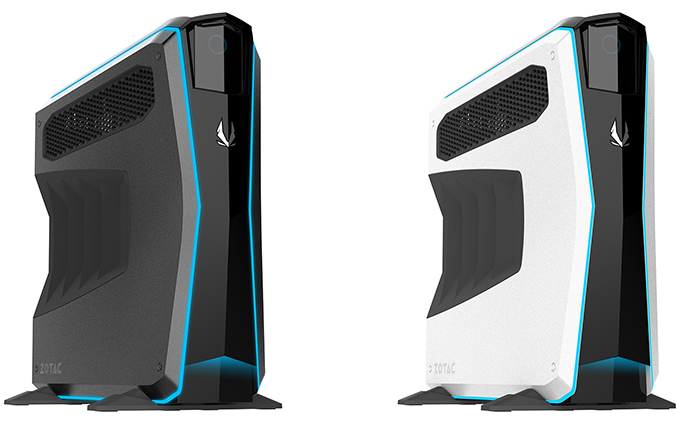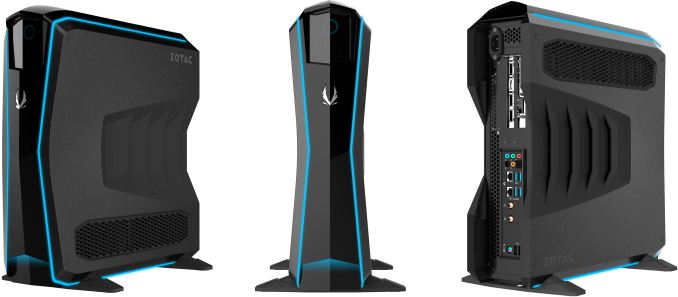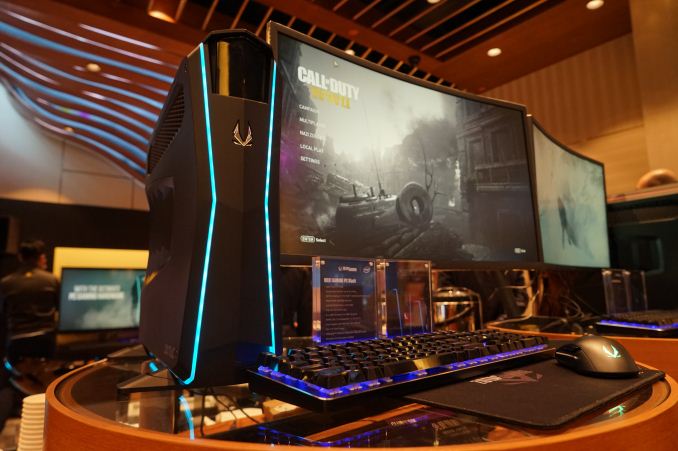ZOTAC Launches MEK1 Upgradeable PCs: Up to Core i7-7700, GeForce GTX 1070 Ti, RGB LEDs
by Anton Shilov on December 11, 2017 2:00 PM EST
ZOTAC this past week formally introduced its first family of upgradeable small form-factor desktops for gamers. The ZOTAC MEK1 systems will come in two configurations, each featuring Intel’s Kaby Lake CPUs as well as NVIDIA’s Pascal GPUs. The MEK1 systems use off-the-shelf components and therefore can be easily upgraded by end users when they need to.
The ZOTAC MEK1 Gaming PCs will come in Black and White chassis themed after “future robotics and mechanical anatomy”. Both systems are based on the same Mini-ITX motherboard featuring Intel’s B250 PCH, they are equipped with 16 GB of dual-channel DDR4-2400 memory, a 240 GB PCIe 3.0 x4 SSD, as well as a 1 TB 2.5” HDD. Meanwhile, the MEK1 Black model is equipped with Intel’s Core i7-7700 processor as well as ZOTAC’s GeForce GTX 1070 Ti graphics card, whereas the MEK1 White is powered by the Core i5-7400 and the GeForce GTX 1060 6 GB. ZOTAC’s MEK1 systems rely on air cooling and take advantage of carefully managed airflows inside the case. The graphics card is installed above the compartment with the CPU and M.2 SSD, so its heat does not affect said devices.
When it comes to connectivity, the MEK1 Black and the MEK1 White systems are identical: they have an 802.11ac Wi-Fi + Bluetooth 4.2 module, two GbE controllers, six USB-A 3.0 ports, two USB-A 2.0 connectors, one PS/2 input, one HDMI 2.0b output, a DL DVI-D header, three DisplayPort 1.4 outputs, analog and S/PDIF audio connectors and so on. For some reason, ZOTAC decided not to equip its MEK1 desktops with USB 3.1 Gen2 Type-C connectors that are present on a number of its other products (1, 2). Some might say that there are not a lot of USB-C peripherals just now, but when you design a PC, you have to think about user experience throughout its lifetime of at least three years. If customers do not enjoy it at the end of its lifespan, they may not come back to ZOTAC for a new one. Meanwhile, USB-C will be widespread three years down the road.
Following the latest trends, both MEK1 PCs feature ZOTAC’s Spectra RGB LED lighting that can be customized using a special utility. To complement the design, MEK1 desktops will come a mechanical keyboard and an optical mouse that match their colors and feature built-in lighting.
| ZOTAC Mek1 Desktops | |||
| Mek1 White MEK1-G11060K500W |
Mek1vBlack MEK1-G1107TK700B |
||
| CPU | Intel Core i5-7400 4C/4T 3 GHz/3.3 GHz 6 MB LLC 65 W |
Intel Core i7-7700 4C/8T 3.6 GHz/4.2 GHz 8 MB LLC 65 W |
|
| PCH | Intel B250 | ||
| Graphics | NVIDIA GeForce GTX 1060 1280 stream processors 80 texture units 48 ROPs 192-bit memory interface 6 GB of GDDR5 9 GT/s memory |
NVIDIA GeForce GTX 1070 Ti 2432 stream processors 152 texture units 64 ROPs 256-bit memory interface 8 GB of GDDR5 8 GT/s memory |
|
| Memory | 16 GB of DDR4-2400 | ||
| Storage | 240 GB PCIe 3.0 x4 SSD 1 TB 2.5" SATA HDD |
||
| Wi-Fi | 802.11ac + BT 4.2 | ||
| Ethernet | Two Gigabit Ethernet with RJ45 connector | ||
| Display Outputs | 1 × DVI-D DL 3 × DisplayPort 1.4 1 × HDMI 2.0 |
||
| Audio | 7.1-channel audio with mini-jack and S/PDIF connector | ||
| USB | 2 × USB 3.0 Type-A (Front) 4 × USB 3.0 Type-A (Back) 2 × USB 2.0 Type-A (Back) |
||
| Other I/O | PS/2 | ||
| RGB Lighting | ZOTAC Spectra | ||
| Dimensions | Height | 393.7 mm | 15.5" | |
| Depth | 414.02 mm | 16.3" | ||
| Width | 118.11 mm | 4.65" | ||
| PSU | 450 W SFX 80+ Bronze | ||
| OS | Windows 10 Home 64-bit | ||
Originally a maker of video cards, today ZOTAC is well known for its compact gaming and office systems. The company’s lineup of PCs is very broad and includes models featuring Intel’s Core i7 CPUs and NVIDIA’s high-end mobile graphics solutions that deliver performance comparable to that of desktop GPUs, but at a lower TDP. Unfortunately, such systems are hard to upgrade because NVIDIA does not allow partners to sell MXM modules to end-users. Therefore, to address people who might want an upgrade path for their PCs, ZOTAC developed its MEK1 systems trying to bring together performance, upgradeability and compact sizes while keeping the price in check. Obviously, some compromises had to be made.
To keep the system sleek, ZOTAC had to use processors with up to 65 W TDP and avoid Intel’s unlocked models that generate up to 95 W of heat or more. Since Intel is gradually increasing performance of its CPUs, TDP constraint is not a problem per se. Since the company uses a motherboard based on Intel’s B250 PCH, the MEK1 systems cannot support Intel’s six-cores Coffee Lake process, eliminating any upgrade options for the Black model and limiting them for the White SKU. One of the reasons why ZOTAC had to choose the Kaby Lake/B250 combination was timing — the desktops have been in development for quite a while. Another reason is availability constraints of Intel’s latest CPUs. ZOTAC’s parent company PC Partner can develop an Intel Z370-based motherboard relatively fast, but if it does not have enough CPUs, ZOTAC cannot sell product, so the safe bet is to go with the Kaby Lake.
The GPU upgrade path is of course considerably simpler — graphics processors to be released in the coming years will be compatible with a PCIe 3.0 x16 interface. Obviously, the MEK1 can accommodate only compact video cards, but they are not rare this days and the system’s 450 W PSU should be enough even for products like the GeForce GTX 1080 Ti (assuming that it can fit in). As for DRAM, M.2 SSD and HDD, their upgrade is as simple as installing new components into an appropriate slot or bay.
ZOTAC plans to start selling its MEK1 systems in the coming weeks. The company did not disclose pricing, but we have reached out ZOTAC and will update the story when we get the information.
Related Reading:
- Zotac Unveils 2017 ZBox Magnus SFF Gaming PCs: Powered By Intel Core & AMD Ryzen
- Zotac Updates ZBOX mini-PCs with Kaby Lake: vPro, Thunderbolt, and More
- Zotac ZBOX MAGNUS EN1080 SFF PC Review: A Premium Gaming Powerhouse
- ZOTAC VR GO Backpack PC Gets Priced: Core i7-6700T, GeForce GTX 1070, $1999
- ZOTAC ZBOX MAGNUS ERX480: SFF PC with Intel Core i5, AMD Radeon RX480, USB-C
- ZOTAC MAGNUS EN980 Detailed - A SFF VR-Ready PC with GeForce GTX 980
Source: ZOTAC



















14 Comments
View All Comments
JoeyJoJo123 - Monday, December 11, 2017 - link
I imagine it's not volumetrically smaller than the Silverstone ML07B, RVZ01B, or FTZ01B...The venting doesn't look adequate for the GPU region, but the CPU region seems like it might be OK enough. (They're mirrored and the exact same size on both sides). On the Silverstone cases, there's two open 120mm fan mounts for the GPU and a single 120mm fan mount for the CPU, with semi-open (or restricted, depending on your viewpoint) ventilation/perforation for the PSU fan.
I'm not really a fan of the gamer-esque design, LEDs (although I guess RGB is better than no-RGB), or the race-car like vented hood like things on the side panels. Although I will say that compared to my current FTZ01B, the case feet when in the vertical position look pretty damn solid.
It all looks adequately specced though, but if I was on the market for small portable prebuilt PC, I'd look at Zotac's other non-upgradable options (I mean, honestly, with Intel's socket/chipset changes with every new CPU generation, you're basically looking at a new Mobo, CPU, and GPU with any PC refresh anyways, at least with AMD there's stability in CPU socket compatibility for CPU upgrades into the future) or MSI's Trident 3 (which looks even smaller, has a separate power brick for easy stuffing into a backpack for LAN party like stuff, and still looks to use a standard 2 PCI-e slot GPU, with obvious length/width restrictions.)
Alternatively, if you want even lower power and even smaller size, then laptop-variant CPUs and GPUs are available in smaller packages, like MSI's Vortex G25 or one of Zotac's other offerings, or yeah, even a gaming laptop. There just isn't a huge delta between mobile and desktop CPU/GPU performance these days outside of the capability of overclocking. For lighter loads, like games at medium to medium-high settings, modern laptops are actually shockingly fine.
romrunning - Monday, December 11, 2017 - link
One big difference between the old mobile CPUs & the new mobile CPUs is that Intel will finally let you have 4-6 cores. That's a pretty big difference, especially if you are doing anything multi-threaded on the laptop.shabby - Monday, December 11, 2017 - link
Are the rgb's upgradable?Reflex - Tuesday, December 12, 2017 - link
No, but you can overclock them....shabby - Tuesday, December 12, 2017 - link
Whoa neat!Alistair - Monday, December 11, 2017 - link
Where is the coffee lake? Wait for purchase...StevoLincolnite - Tuesday, December 12, 2017 - link
Yeah... Only a quad-core as we are about to enter 2018 is a stretch.bill.rookard - Monday, December 11, 2017 - link
Hmm.. A Ryzen 7 1700 is a 65w CPU. Paired with a good GPU (GTX1080) it would be an excellent gaming / work machine.Alexvrb - Monday, December 11, 2017 - link
Having a couple Ryzen options would be nice, including more affordable Ryzen 5 models. The 1070 Ti is within a hair of the 1080 though, I think it's probably the better value. No harm in offering them both though.ddriver - Monday, December 11, 2017 - link
Oh wow, UPGRADEABLE PC - luxury feature... what has this world come to... PCIE ribbon cables - we are truly living in the future.